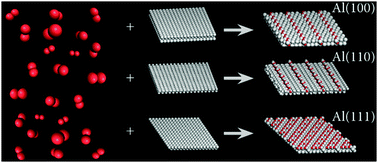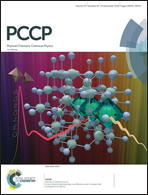The first stages of oxide growth at the low index Al surfaces (100), (110), (111): clusters and stripes vs. homogeneous growth
Abstract
We performed a density functional theory (DFT) investigation of the mechanisms of oxide growth at Al(100), Al(110) and Al(111) up to 1 monolayer (ML) coverage of O-atoms with 0.125 ML increments. We found that the surface binding site preferences of O-atoms are largely affected by the presence of neighboring O-atoms. Based on this we constructed two oxide growth models: the formation of clusters that evolve to stripes with increasing coverage and the formation of a more homogeneous distribution of O-atoms. While the former model is characterized by a lower symmetry of distribution of O-atoms at the surfaces, the latter corresponds to higher symmetries. We found that the prevalence of each oxide growth mode depends on the coverage of O-atoms and that this dependency is different for each surface. For Al(100) and Al(110), up to coverages of 1 ML the oxide grows preferably via the formation of clusters that evolve to stripes with increasing coverage, while for Al(111) the stripes and clusters are the preferred growth mode for coverages up to 0.375 ML, beyond which the homogeneous growth mode is energetically favored. The calculated Al–O pair distribution functions show that the formation of clusters and stripes leads to shorter Al–O bond lengths when compared to the homogeneous growth. The oxides formed at Al(100) and Al(110) have Al–O bond lengths and geometries typical of the shorter bonds of α-alumina while at Al(111) the bond lengths are typical of γ-alumina and β-alumina. These results suggest that for low coverages, the oxides formed at Al(100) and Al(110) are resemblant of defective α-alumina while the oxide formed at Al(111) is similar to less disordered γ-alumina and β-alumina. For Al(111), the small energy difference between the growth of clusters and stripes and homogeneous growth does not exclude the coexistence of both growth modes; this could lead to the formation of a defective or amorphous oxide.



 Please wait while we load your content...
Please wait while we load your content...